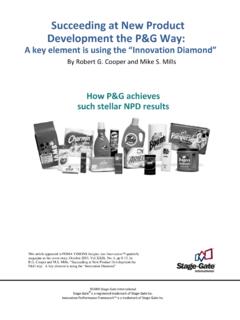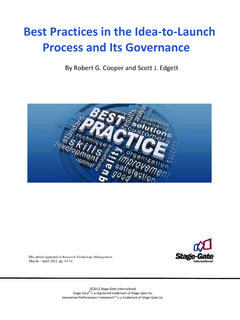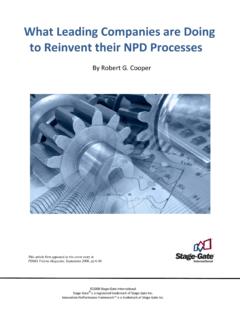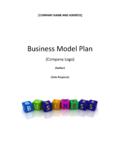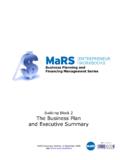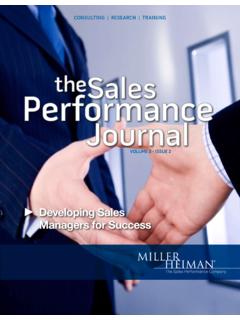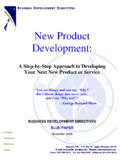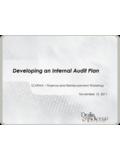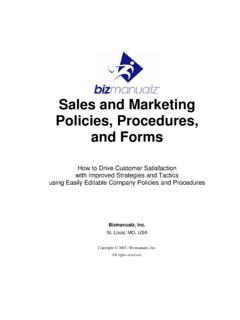Transcription of Developing a Product Innovation and Technology …
1 Developing a Product Innovation and Technology strategy for your Business By Robert G. Cooper and Scott J. Edgett This article appeared in Research Technology Management May June 2010, Vol 53, pp. 33-40 2010 Stage Gate International Stage Gate is a registered trademark of Stage Gate Inc. Innovation Performance Framework is a trademark of Stage Gate Inc. May June 2010330895-6308/10/$ 2010 Industrial Research Institute, A Product Innovation AND Technology strategy FOR your BUSINESSA framework for Developing a Product Innovation strategy includes defi ning Innovation goals and objectives, selecting strategic arenas, Developing a strategic map, and allocating G. Cooper and Scott J. EdgettOVERVIEW: Many companies lack a clearly articu-lated and well-communicated Product Innovation and Technology strategy . Such a strategy is essential and is strongly linked to positive performance in Product inno-vation.
2 A framework for Developing a Product innova-tion strategy is presented, and the various steps of strategy development are described, from best-practice ways to defi ne Innovation goals and objectives through to the selection of strategic arenas and the development of the strategic map. Defi ning attack plans and entry strategies are also described. Finally, methods for re-source allocation and deployment using strategic buckets and strategic roadmaps are CONCEPTS: Innovation strategy , Product develop-ment strategy , strategic arenas, strategic buckets, road-maps, entry strategiesIn the late 1990s, two large fi rms were growing by leaps and bounds, driven by the boom in fi ber-optic communi-cations. They were Corning Glass, which manufactured fi ber-optic cable, and Nortel Networks, which produced the boxes at each end of the cable to convert the light signal into an electronic signal.
3 Then came the crash of 2000; overnight, both fi rms sales plummeted, and their share prices plunged from over $100 to about $1. Ten years later, Corning is thriving, whereas Nortel is in Chapter 11 and being broken up. Why? How did two great and innovative companies, facing the same crisis, end up so differently a short decade later? One reason for Nortel s demise is that the company lacked direction and an Innovation strategy after the crash; instead, it limped along from one ad hoc decision to the next. By contrast, Corning s senior management took charge, developed a strong Product Innovation and Technology strategy for the fi rm, and provided leadership and direction to see that strategy through (1). Corning s management took a hard look at the company s previous 100 years of successes in Innovation and what drove them. They concluded that the repeatable keys to success the elements in Corning s culture and history that they could draw on to face this new challenge were a leadership commitment, a clear understanding of the company s capabilities, a strong connection to the customer and a deep understanding of major customer problems, and a willingness to take big but well-understood risks.
4 Strongly committed to breaking out of the crisis through Innovation , manage-ment assessed Corning s core competencies, determined what they could leverage, and matched those strengths to emerging and adjacent market opportunities. The result was a renewed Innovation strategy and a three-pronged strategic attack that called for the company Dr. Robert G. Cooper is Emeritus Professor, DeGroote School of Business, McMaster University, Hamilton, ON, Canada; ISBM Distinguished Research Scholar at Penn State s Smeal College of Business Administration; and President of the Product Development Institute. Cooper is an acknowledged global expert in the fi eld of Innovation management, a Fellow of the PDMA, and creator of the Stage-Gate new- Product process used by many fi rms to drive new products to market. He is a prolifi c researcher and publisher in the fi eld of innova-tion management, with over 100 articles and six Edgett is CEO and co-founder of the Prod-uct Development Institute and Stage-Gate, Inc.
5 , and is also a Faculty Scholar with ISBM at Penn State University s Smeal College of Business Adminis-tration. A specialist in new Product development and portfolio management, he received his in marketing from Bradford University. He has con-sulted and written extensively in the fi eld, with over 60 published articles and six books. His latest book (co-authored with Robert Cooper) is Product Innova-tion and Technology strategy (Toronto: PDI, 2009).. Technology Management34to grow current businesses via Product -line extensions, exploit market adjacencies, and create totally new oppor-tunities. The latter two thrusts required a heavy emphasis on exploratory research and new business development, and thus, in spite of fi nancial diffi culties, R&D spending was maintained at 10 percent of sales revenue. A number of new opportunities and strategic arenas were identifi ed and assessed, and the most promising were exploited.
6 The results were impressive: By 2008, major innova-tions had been realized in each of Corning s businesses, including the creation of four new business platforms and exploitation of three major market adjacencies. New Product sales had rocketed to 70 percent of annual sales, and profi ts moved from minus $500 million to plus $2 billion after taxes. The example of Corning offers some important strate-gic lessons for today, as we emerge from the current re-cession. As the Corning case illustrates, an Innovation strategy is an essential tool for Product development and continued growth even in diffi cult times. Indeed, our research has shown that top-performing busi-nesses have in place a Product Innovation and Technology strategy driven by the business leadership team and a strategic vision of the business (2). As it does at Corning, this strategy guides the business s Product development An Innovation strategy is an essential tool for Product development and continued growth even in diffi cult 1.
7 Best-performing businesses develop a Product Innovation and Technology strategy , which includes elements noted here. Best performers are the top 20% of businesses, gauged on a number of performance metrics, including percent sales by new products; ROI on R&D spending; meeting sales, profi t, and timing targets; and others (2).efforts and helps to steer resource allocation and project selection. A comprehensive Product Innovation strategy must include, among other elements, clearly defi ned ob-jectives and defi ned strategic areas of focus; it must have a widely understood role in broader business goal. Further, the Innovation strategy implemented in June 201035best-performing businesses is more than just a list of this year s development projects; it has a much longer-term commitment. Companies with effective Product Innovation programs rely on a number of tools to im-plement them, including strategic buckets for resource allocation and strategic Product roadmaps.
8 Across the board, top-performing businesses build these elements into their Product Innovation strategy ; poorly perform-ing businesses do not. For example, on average, only of businesses develop a Product roadmap, but best performers are about twice as likely to use road-maps as poor performers (Figure 1). There is an even greater discrepancy in the use of strategic buckets, a resource allocation strategy that ensures availability of resources for critical products, with of top performers and only of poor performers using strategic buckets. The message for senior management is that if your busi-ness lacks a Product Innovation strategy that includes these key elements, this defi ciency is likely hurting your business s performance. The time is ripe to develop and install such a strategy , an effort that should be led by the business s leadership team.
9 Developing a Product Innovation strategy requires sustained, high-level effort; the work can be facilitated and guided by the use of a framework. The strategy development framework we developed based on observations from our study of best-performing businesses can be a helpful tool (Figure 2). This guide serves as a useful starting point to develop your own Product Innovation With Goals and Objectives strategy begins with the goals for the business s Product Innovation effort and a clear understanding of how these Product Innovation goals tie into the broader business goals. Many businesses lack Product Innovation goals, or the goals are not articulated and communicated well. In Corn-ing s case, the goals were ambitious: to innovate their way out of a business crisis and to double the rate of creation of new businesses per decade.
10 These goals were supported by specifi c sales and profi t objectives for Product innova-tion. Note that goals are broad and give general intentions, whereas objectives are narrow, concrete, and precise. Like Corning s, your business s Product Innovation strategy should specify the goals and objectives of the business s total Product Innovation effort and indicate the role that Product Innovation will play in helping the business achieve its objectives (3). your Product inno-vation strategy must answer the question: How do new products and Product Innovation fi t into the business s overall plan? The most popular objective (and metric) is percentage of the business s annual sales generated from new prod-ucts. Here a new Product is usually defi ned as one that strategy begins with the goals for the business s Product Innovation effort and a clear understanding of how these Product Innovation goals tie into the broader business been on the market three years or less and that is vis-ibly different to the customer from previous offerings, for example a Product with new features, functionality, or performance characteristics.

